Abstract
Congenital chloride diarrhea (CCD) is a rare autosomal recessive disorder, characterized by watery stools with C1- concentration around 150 meq/liter. We have perfused the colon of three patients and their three healthy siblings with different salt solutions containing 36C1- to determine the nature of the colonic defect in CCD. In the controls, net absorption of Na+ and C1- occurred against steep concentration gradients. The influx (lumen-to-plasms flux) of C1- was twice the effux. Omission of HCO3- from the perfusate caused a clear decrease in C1- efflux which suggests a coupling of C1- effux to HCO3- influx. In CCD, net Na+ absorption occurred normally when HCO3- was present in the lumen. However, Na+ absorption was always impaired when the luminal contents were acid, a situation that prevails in CCD. Net K+ secretion was clearly increased. Both influx and efflux of C1- were practically absent. Only slight net secretion occurred along a steep gradient. Net appearance of HCO3- was not observed, in contrast to controls. These findings and earlier studies of ileal function in CCD are best explained by a defect in the C1-/HCO3- exchange mechanism, which operates in both directions in the normal ileum and colon.
Full text
PDF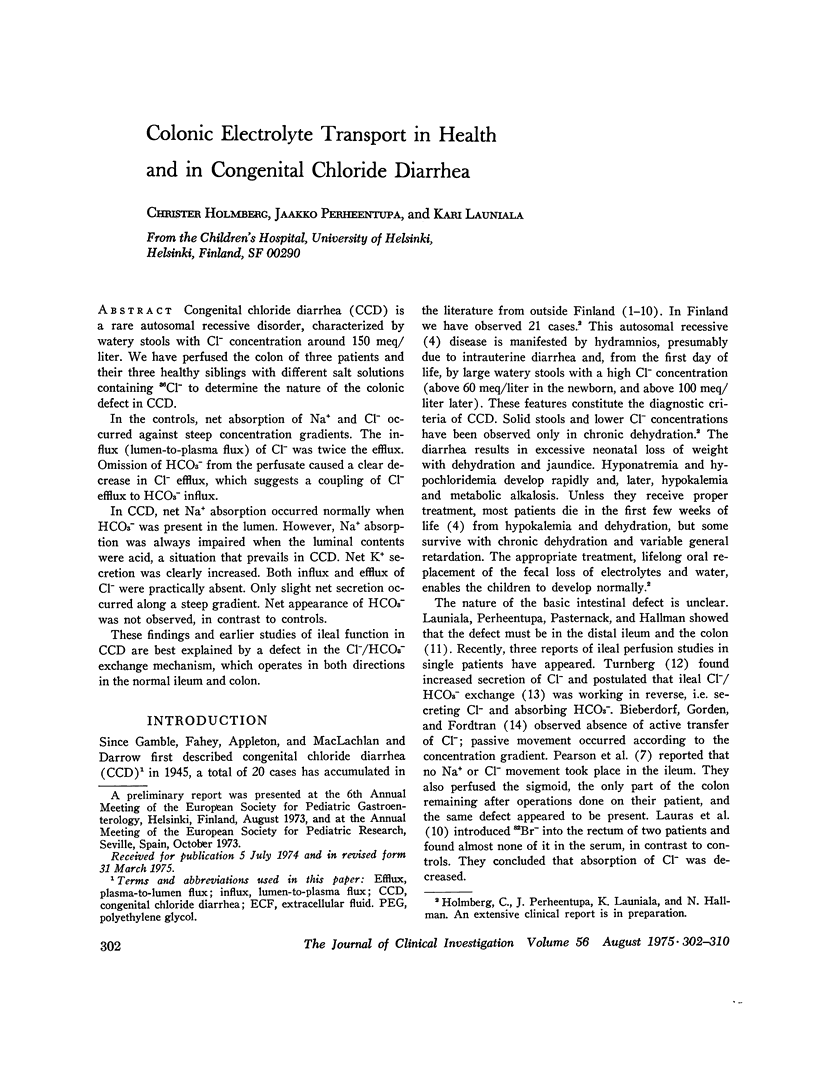
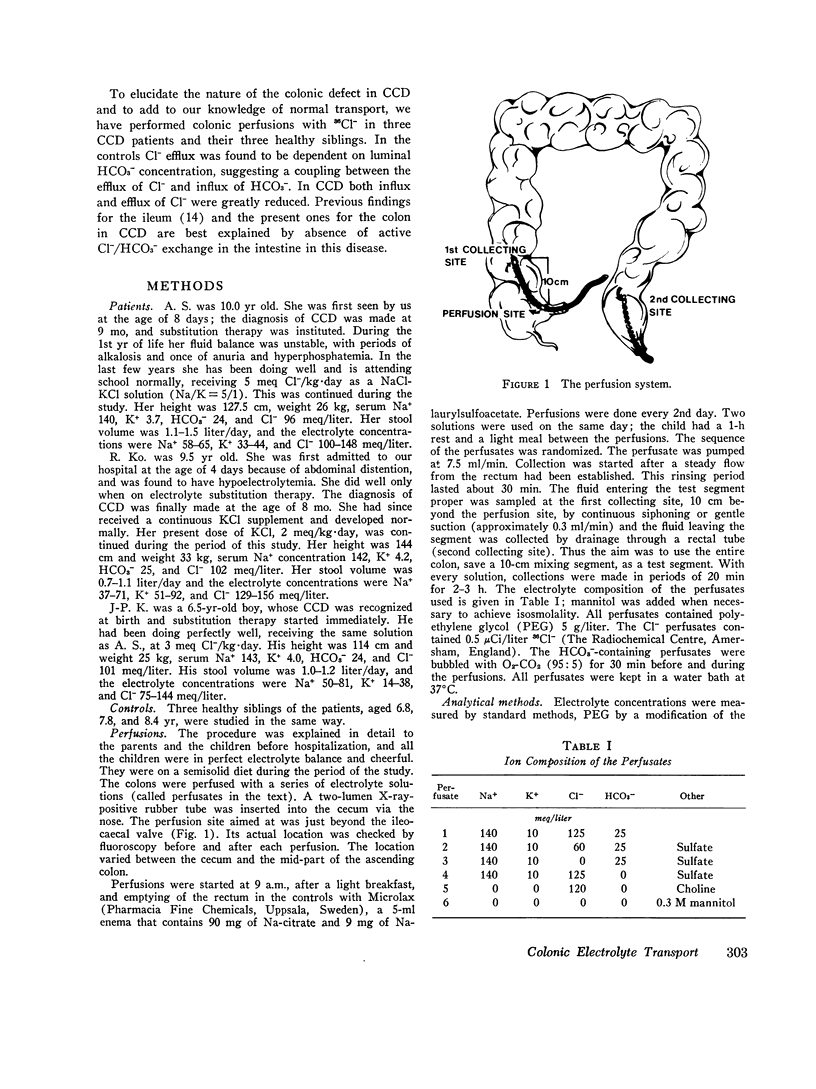
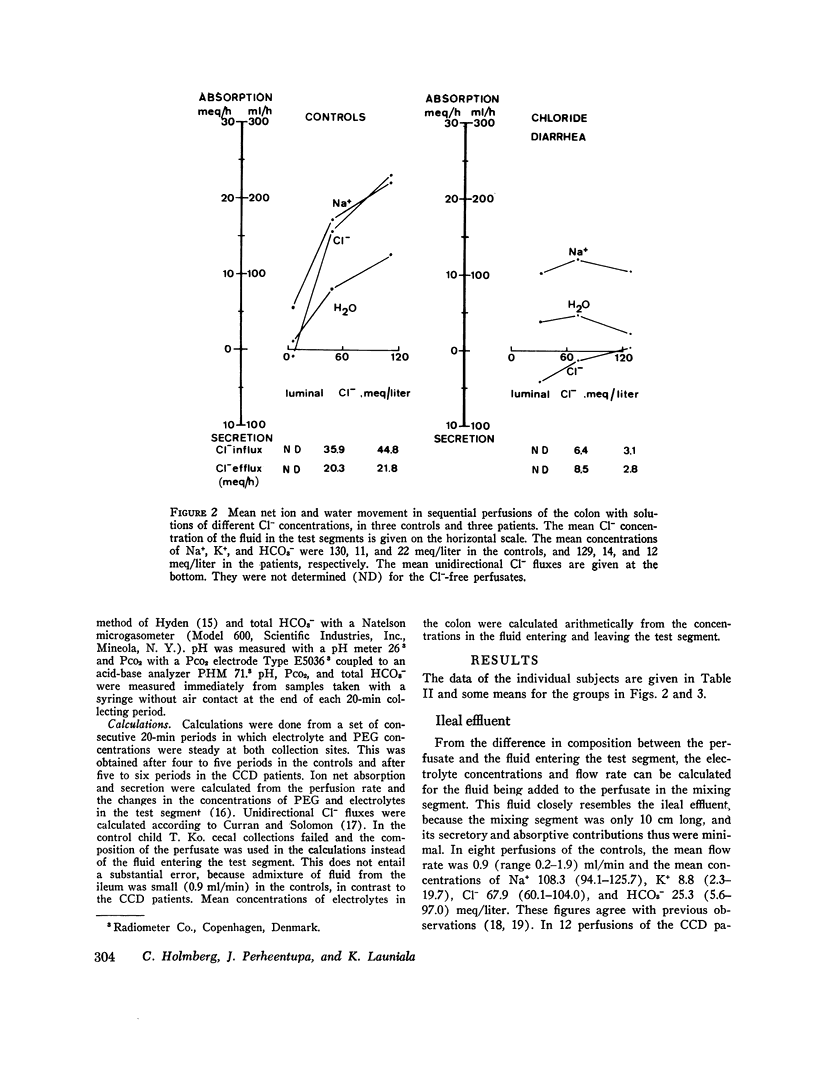
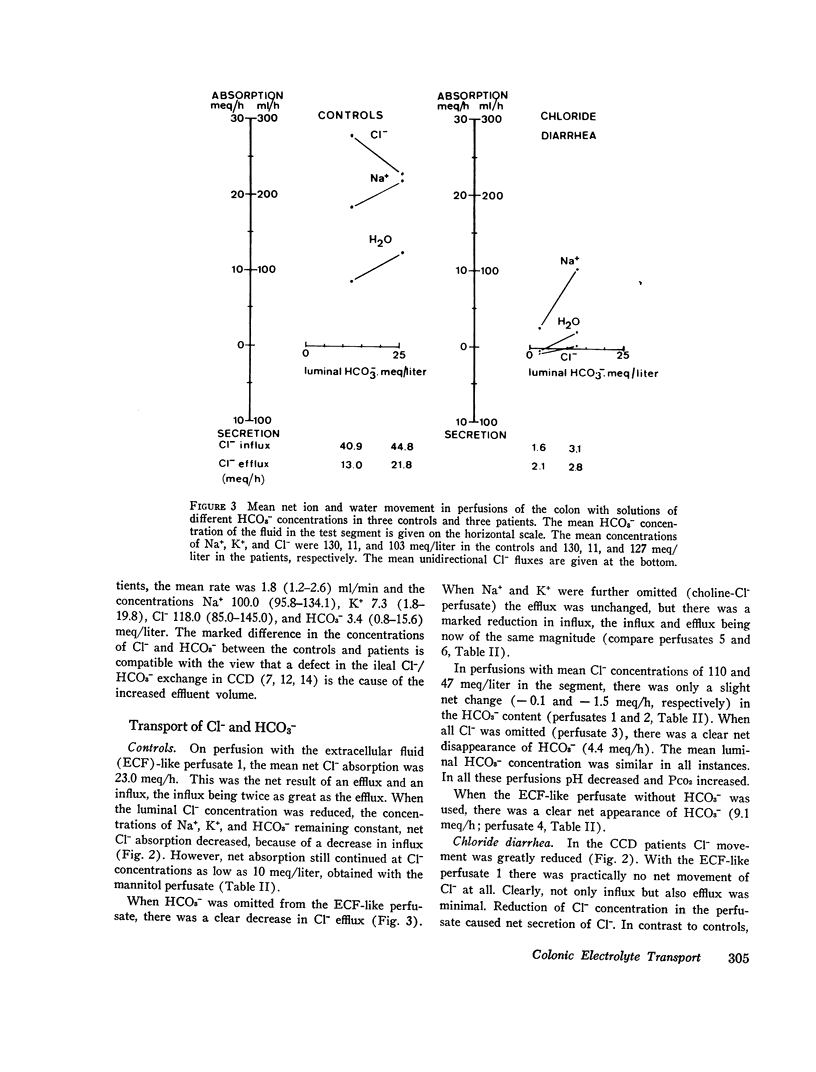
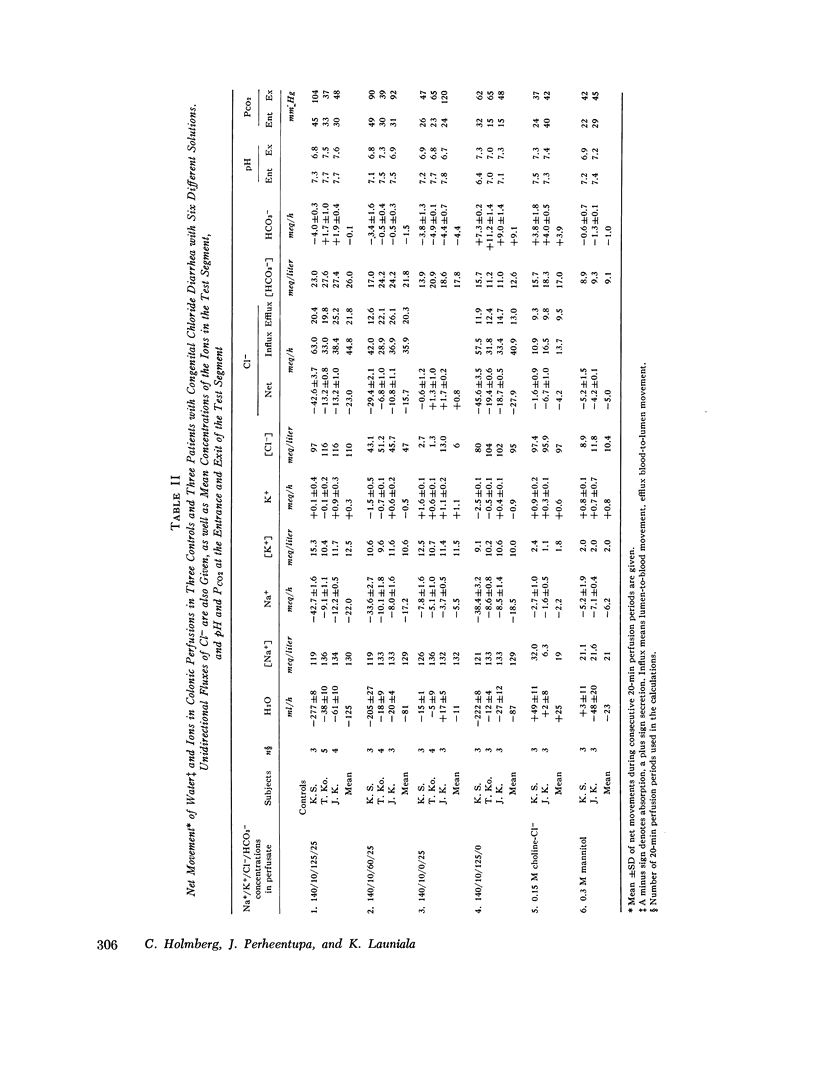
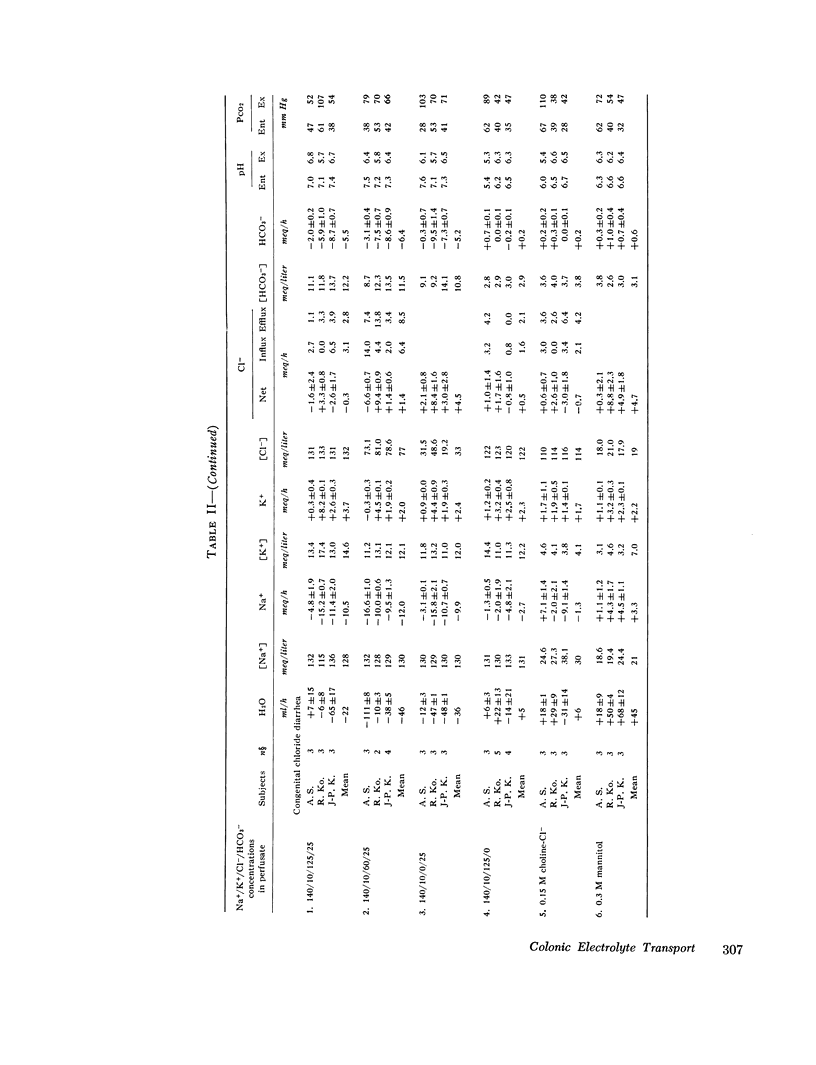
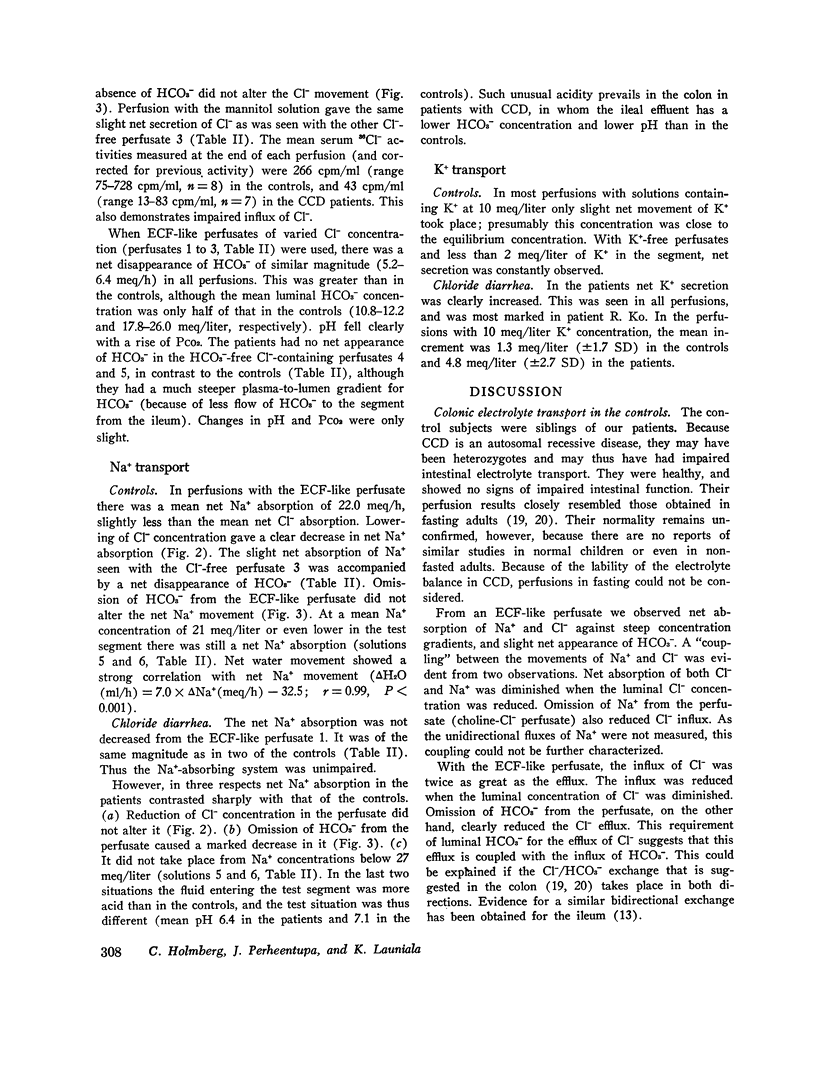
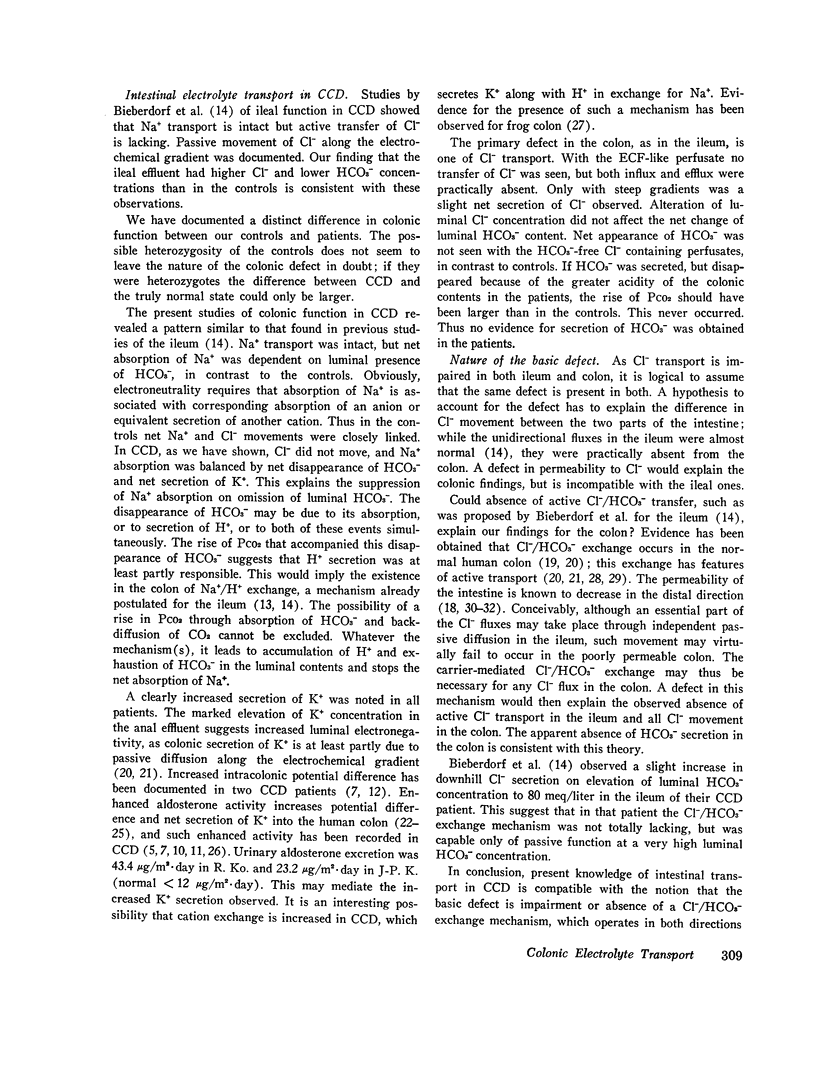
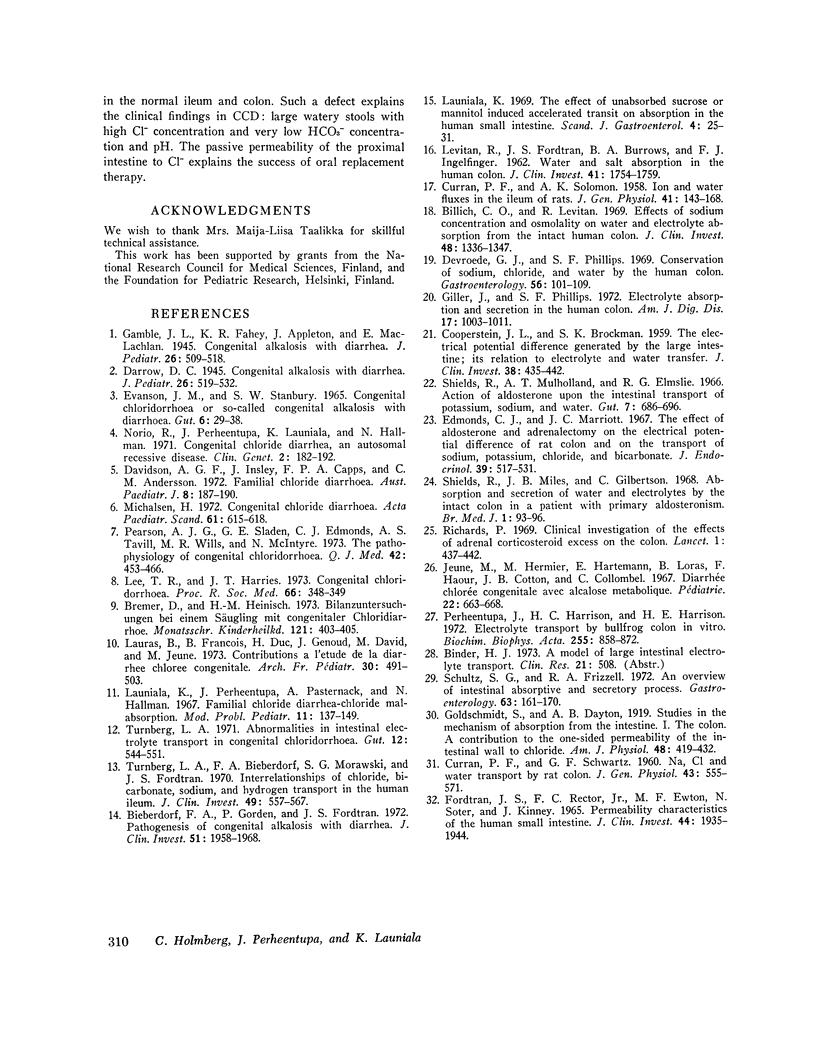
Selected References
These references are in PubMed. This may not be the complete list of references from this article.
- Bieberdorf F. A., Gorden P., Fordtran J. S. Pathogenesis of congenital alkalosis with diarrhea. Implications for the physiology of normal ileal electrolyte absorption and secretion. J Clin Invest. 1972 Aug;51(8):1958–1968. doi: 10.1172/JCI107002. [DOI] [PMC free article] [PubMed] [Google Scholar]
- Billich C. O., Levitan R. Effects of sodium concentration and osmolality on water and electrolyte absorption form the intact human colon. J Clin Invest. 1969 Jul;48(7):1336–1347. doi: 10.1172/JCI106100. [DOI] [PMC free article] [PubMed] [Google Scholar]
- Bremer D., Heinisch H. M. Bilanzuntersuchungen bei einem Säugling mit congenitaler Chloriddiarrhoe. Monatsschr Kinderheilkd. 1973 Jul;121(7):403–405. [PubMed] [Google Scholar]
- COOPERSTEIN I. L., BROCKMAN S. K. The electrical potential difference generated by the large intestine: its relation to electrolyte and water transfer. J Clin Invest. 1959 Feb;38(2):435–442. doi: 10.1172/JCI103818. [DOI] [PMC free article] [PubMed] [Google Scholar]
- CURRAN P. F., SCHWARTZ G. F. Na, Cl, and water transport by rat colon. J Gen Physiol. 1960 Jan;43:555–571. doi: 10.1085/jgp.43.3.555. [DOI] [PMC free article] [PubMed] [Google Scholar]
- CURRAN P. F., SOLOMON A. K. Ion and water fluxes in the ileum of rats. J Gen Physiol. 1957 Sep 20;41(1):143–168. doi: 10.1085/jgp.41.1.143. [DOI] [PMC free article] [PubMed] [Google Scholar]
- Davidson A. G., Insley J., Capps F. P., Anderson C. M. Familial chloride diarrhoea (congenital alkalosis with diarrhoea). Aust Paediatr J. 1972 Aug;8(4):187–190. doi: 10.1111/j.1440-1754.1972.tb01818.x. [DOI] [PubMed] [Google Scholar]
- Devroede G. J., Phillips S. F. Conservation of sodium, chloride, and water by the human colon. Gastroenterology. 1969 Jan;56(1):101–109. [PubMed] [Google Scholar]
- EVANSON J. M., STANBURY S. W. CONGENITAL CHLORIDORRHOEA OR SO-CALLED CONGENITAL ALKALOSIS WITH DIARRHOEA. Gut. 1965 Feb;6:29–38. doi: 10.1136/gut.6.1.29. [DOI] [PMC free article] [PubMed] [Google Scholar]
- Edmonds C. J., Marriott J. C. The effect of aldosterone and adrenalectomy on the electrical potential difference of rat colon and on the transport of sodium, potassium, chloride and bicarbonate. J Endocrinol. 1967 Dec;39(4):517–531. doi: 10.1677/joe.0.0390517. [DOI] [PubMed] [Google Scholar]
- Fordtran J. S., Rector F. C., Jr, Ewton M. F., Soter N., Kinney J. Permeability characteristics of the human small intestine. J Clin Invest. 1965 Dec;44(12):1935–1944. doi: 10.1172/JCI105299. [DOI] [PMC free article] [PubMed] [Google Scholar]
- Giller J., Phillips S. F. Electrolyte absorption and secretion in the human colon. Am J Dig Dis. 1972 Nov;17(11):1003–1011. doi: 10.1007/BF02239140. [DOI] [PubMed] [Google Scholar]
- Jeune M., Hermier M., Hartemann E., Loras B., Haour F., Cotton J. B., Collombel C. Diarrhée chlorée congénitale avec alcalose métabolique. Pediatrie. 1967 Sep;22(6):663–683. [PubMed] [Google Scholar]
- LEVITAN R., FORDTRAN J. S., BURROWS B. A., INGELFINGER F. J. Water and salt absorption in the human colon. J Clin Invest. 1962 Sep;41:1754–1759. doi: 10.1172/JCI104634. [DOI] [PMC free article] [PubMed] [Google Scholar]
- Launiala K. The effect of unabsorbed sucrose- or mannitol-induced accelerated transit on absorption in the human small intestine. Scand J Gastroenterol. 1969;4(1):25–32. doi: 10.3109/00365526909180147. [DOI] [PubMed] [Google Scholar]
- Lauras B., François B., Duc H., Genoud J., David M., Jeune M. Contribution a l'étude de la diarrhée chlorée congénitale. Arch Fr Pediatr. 1973 May;30(5):491–503. [PubMed] [Google Scholar]
- Michalsen H. Congenital chloride diarrhoea. Experience with a new case. Acta Paediatr Scand. 1972 Sep;61(5):615–618. doi: 10.1111/j.1651-2227.1972.tb15956.x. [DOI] [PubMed] [Google Scholar]
- Norio R., Perheentupa J., Launiala K., Hallman N. Congenital chloride diarrhea, an autosomal recessive disease. Genetic study of 14 Finnish and 12 other families. Clin Genet. 1971;2(3):182–192. [PubMed] [Google Scholar]
- Pearson A. J., Sladen G. E., Edmonds C. J., Tavill A. S., Wills M. R., McIntyre N. The pathophysiology of congenital chloridorrhoea. Q J Med. 1973 Jul;42(167):453–466. [PubMed] [Google Scholar]
- Perheentupa J., Harrison H. C., Harrison H. E. Electrolyte transport by bullfrog colon in vitro. Biochim Biophys Acta. 1972 Mar 17;255(3):858–872. doi: 10.1016/0005-2736(72)90398-7. [DOI] [PubMed] [Google Scholar]
- Richards P. Clinical investigation of the effects of adrenal corticosteroid excess on the colon. Lancet. 1969 Mar 1;1(7592):437–442. doi: 10.1016/s0140-6736(69)91480-9. [DOI] [PubMed] [Google Scholar]
- Schultz S. G., Frizzell R. A. An overview of intestinal absorptive and secretory processes. Gastroenterology. 1972 Jul;63(1):161–170. [PubMed] [Google Scholar]
- Shields R., Miles J. B., Gilbertson C. Absorption and secretion of water and electrolytes by the intact colon in a patient with primary aldosteronism. Br Med J. 1968 Jan 13;1(5584):93–96. doi: 10.1136/bmj.1.5584.93. [DOI] [PMC free article] [PubMed] [Google Scholar]
- Shields R., Mulholland A. T., Elmslie R. G. Action of aldosterone upon the intestinal transport of potassium, sodium, and water. Gut. 1966 Dec;7(6):686–696. doi: 10.1136/gut.7.6.686. [DOI] [PMC free article] [PubMed] [Google Scholar]
- Turnberg L. A. Abnormalities in intestinal electrolyte transport in congenital chloridorrhoea. Gut. 1971 Jul;12(7):544–551. doi: 10.1136/gut.12.7.544. [DOI] [PMC free article] [PubMed] [Google Scholar]
- Turnberg L. A., Bieberdorf F. A., Morawski S. G., Fordtran J. S. Interrelationships of chloride, bicarbonate, sodium, and hydrogen transport in the human ileum. J Clin Invest. 1970 Mar;49(3):557–567. doi: 10.1172/JCI106266. [DOI] [PMC free article] [PubMed] [Google Scholar]


